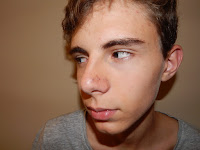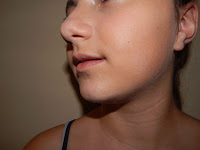Colors are truly something. Imagine what would it be like to live in a world that's only black and white. No shades of grey -just one or the other. Imagine what would it be like to no associate dawn with the blend of blue and yellow and orange. Imagine what would it be like to lose an entire spectrum of adjectives. Imagine what would it be like to not have a favorite color.
This is the story of how a color scheme changed the design of my whole magazine.
As I have posted, the design for my table of contents was pretty much done. I had the whole discussion with my peer and teacher about it, came home, processed everything and decided to do the following: I'd go to school and ask people around. And so I did. There was mixed feelings about it, but the common reaction was "It is a bit overwhelming at first, but when you stop to read it, it makes sense". Tried figuring out other ways to layout it -didn't work. So I had another discussion with Mrs. Stoklosa and she said that the table of contents needs to meet its set requirements; mine does not.
I came home, bummed out, pretty hopeless, but of course, I sat in front of the computer and got to work. "You have to progress", I told myself. "You have to have SOMETHING done today." Finally, I gave up on my table of contents -for the mean time- and decided to start my two page spread. I clicked on Illustrator, which had spent the entire day sitting on my desktop, waiting for me to play with it, and created a new document. A new, white, plain document, awaiting so many great things that I panicked for a second, not wanting to disappoint it. "What now?", I asked myself. "I don't know", I replied. "Oh, what about looking at some covers? Yes." -I have no idea why my mind thinks the way it does, honestly.
 |
| Cute, cute, and cute. |
On the second group meeting we had, among the people in my group there was Suzie, and she shared a VERY cool
article with me, which ended up serving as inspiration. The article features 70 magazine covers and they are all oh so beautiful. As I was scrolling down I noticed a pattern: even though most covers have a lot of color and movement going on, they manage to keep a clean, elegant look, and still look
super artistic. I was jealous during the process, thinking about the ingenious mind of the people who create these magazines, but I got inspired.
So I resorted to my second best friend, Google, and searched up "color schemes". Looked around for a bit until I found
this beauty (to the right, which is actually some painting I made with Photoshop while I was testing the colors). I simply love all the colors. The beige is really neutral and can be used to contrast with the other two colors, but it also stands out against white; the lilac brings a feeling of luxury, elegance; the blue has a calming effect, an easy color -going all color psych right now; plus, this brush effect I've used creates the artistic side of the magazine. All that embodies the "feeling" I'm trying to bring for 1867.
But colors weren't enough -I needed more. During class today it was suggested to me to use the circular shape with a bunch of words inside on the cover, and that suggestions stuck. So as soon as I saw the color scheme I thought about eliminating the circle from the TOC, and instead playing with the colors, that way I could move the circle to the cover -and, really, still play with the colors. In a second, everything became quite clear in my mind. The cover will be very simple, but powerful at the same time; the two two-page spread are becoming something new -the mix between the conventions and my own idea; the TOC will be clear and neat, but playful. And yes, this is not much information about anything, but it soon enough will be.
I should have my two page spread done later today, and I'll get started on the cover right away. After the traumatic experience with the table of contents I'm leaving it for last now.
If I don't get enough sleep because I'm working on a total different magazine now, I'll blame it on Google and its insane habit of providing easy accessibility to color schemes.
"70 Most Beautiful Print Magazine Covers." Design Dose. Web. 5 Apr. 16. <http://designdo.se/70-most-beautiful-print-magazine-covers/>.


 Don't judge the pictures too harshly, please. The composition was INTENDED -I didn't simply take pictures; I had a limited window of time, these children were complaining throughout the whole thing. I focused on the features I wanted and positioned them in a way that the flash would hit such features perfectly. (Barely can call me a professional photographer, but hey, I got the job done.) Pictures taken, Photoshop called, and I, eager to play with the many brushes and pencils and pens (IT IS INCREDIBLY FUN OVER THERE, I SWEAR), started editing the pictures...ops. My idea was to embody my palette on the images, and I achieve that in a way... just not how I was imagining it.
Don't judge the pictures too harshly, please. The composition was INTENDED -I didn't simply take pictures; I had a limited window of time, these children were complaining throughout the whole thing. I focused on the features I wanted and positioned them in a way that the flash would hit such features perfectly. (Barely can call me a professional photographer, but hey, I got the job done.) Pictures taken, Photoshop called, and I, eager to play with the many brushes and pencils and pens (IT IS INCREDIBLY FUN OVER THERE, I SWEAR), started editing the pictures...ops. My idea was to embody my palette on the images, and I achieve that in a way... just not how I was imagining it. 

